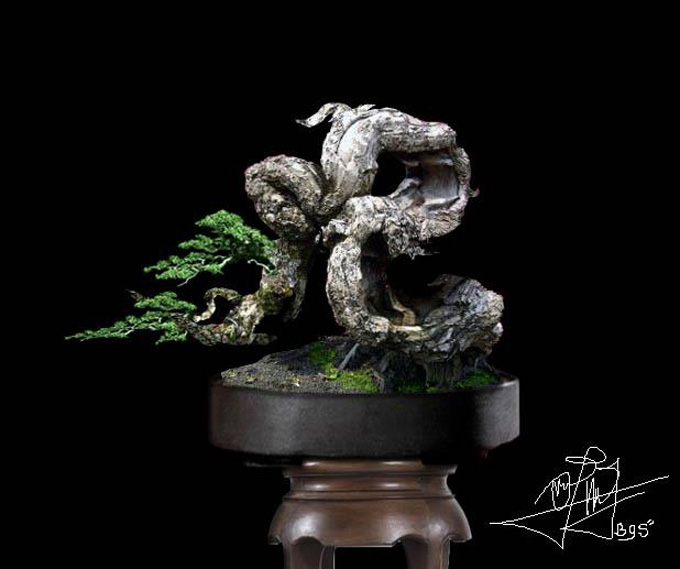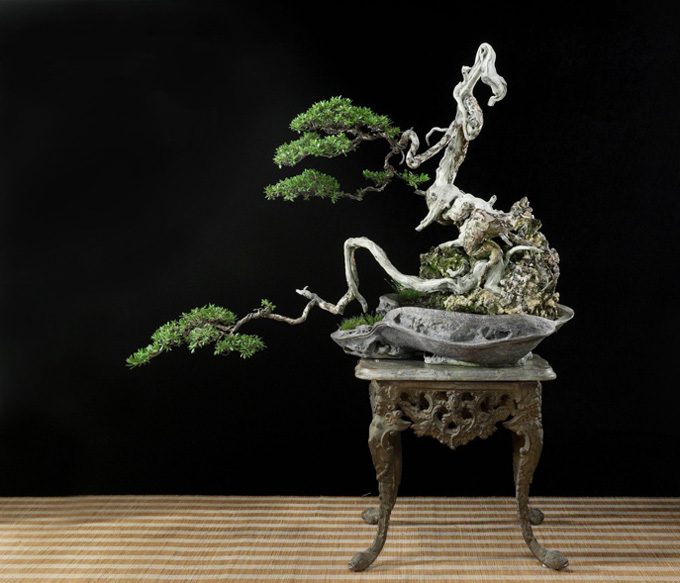 I think this wonderfully convoluted beast belongs to Yusuf Sirait; at least it appears on his facebook page. It’s a Pemphis acidula (Santigi).
I think this wonderfully convoluted beast belongs to Yusuf Sirait; at least it appears on his facebook page. It’s a Pemphis acidula (Santigi).
Bonsai paradise
I wonder just how common naturally contorted wild bonsai stock are on the islands of Indonesia. Based on what I’ve seen online and elsewhere, it’s easy to get the impression that they are so abundant that all you have to do is walk out your door, bend over and pick a few. Somehow though, I doubt that’s the case. If fact, I seem to remember photos from Robert Steven’s Mission of Transformation, that show Robert and friends going to a considerable amount of trouble (even dangerous trouble) to collect wild trees (here’s a relevant post from 2009). Still, Indonesian bonsai artists seem to come up with an endless supply of high quality collected bonsai, and the ones shown here are no exception.
 The wild contortions on this one are a bit more expansive, but nature’s ravages combined with skilled human hands make for the same delightful results. This one belongs to Budi Sulistyo (author of Tropical Bonsai Gallery). The photo is from ofbonsai.org.
The wild contortions on this one are a bit more expansive, but nature’s ravages combined with skilled human hands make for the same delightful results. This one belongs to Budi Sulistyo (author of Tropical Bonsai Gallery). The photo is from ofbonsai.org.
 I don’t think we can go any further without showing one of Robert Steven’s masterpieces. Robert is a bright star in the Indonesian bonsai universe and this gnarly old tree is a good example of what his skillful hands and eyes can do with powerful collected material. The photo is from the gallery on Robert’s blog. BTW: Robert is a frequent contributor to this blog and author of two of our favorite bonsai books.
I don’t think we can go any further without showing one of Robert Steven’s masterpieces. Robert is a bright star in the Indonesian bonsai universe and this gnarly old tree is a good example of what his skillful hands and eyes can do with powerful collected material. The photo is from the gallery on Robert’s blog. BTW: Robert is a frequent contributor to this blog and author of two of our favorite bonsai books.
These are breathtaking! I love the degree of folliage reduction; it gives tremendous strength and magnitude to the trunks, and allows us to focus more on the trunk lines & textures.
They are, indeed, gorgeous!
I do wish that cultivar identity was available as well!
Great trees and, as always, insightful comments. I suspect that there is a certain percentage of hidden masterpieces waiting in any mountainous terrain. The Japanese and Chinese started finding theirs sooner, that’s all! :-)
Hi Michael,
Yes. Judicious foliage reduction on trees with magnificent wood works. If you’ve got it, why not flaunt it?
Hi Paj,
As far as I know, all three are collected, so are not cultivars. I think they are all Pemphis acidula.
Hi Steve,
I’m sure that is correct, though some mountains are better endowed with potential bonsai than others. Around here in New England, it’s surprising how little good material there is. There are some sweet spruces way up high in the White and Green Mountains that have potential, but they are almost all in rocky crevices and very difficult to collect, not to mention that our spruce varieties (white, black and red) don’t seem to like to be dug that much and most are on public lands (someone correct me if they know differently). However, there are collectable trees in the Northeast US (especially larches, which tend to grow in lower elevations), and if anyone is interested in the topic, I suggest Nick Lenz’ great book, Bonsai from the Wild. http://www.stonelantern.com/SearchResults.asp?Search=b1lenz&Search.x=12&Search.y=5
Bonsai Living art of nature created by humenbeing a master peace preasention.